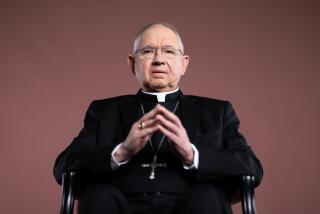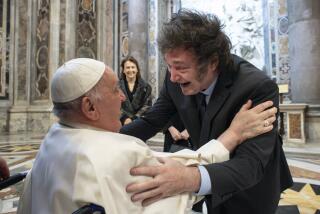Pope Francis, a New World pontiff, faces old challenges
- Share via
VATICAN CITY — Jorge Mario Bergoglio of Argentina became the first pope from the Americas and the first from outside Europe in more than a millennium in an election that recognized a shift in the Roman Catholic Church’s center of gravity while maintaining its conservative theology.
The new Pope Francis, the 266th in the church’s history, is immediately confronted with daunting challenges. His flock is growing rapidly in some parts of the globe but is disenchanted and shrinking elsewhere. The Vatican bureaucracy is widely thought to need sweeping reform and the church is still struggling with the legacy of its sex abuse scandal.
But his election represented a gentle earthquake for an institution steeped in tradition: a major departure geographically, yet a continuation theologically with his conservative predecessors, the late John Paul II and Benedict XVI, whose surprise resignation last month threw the church into uncertainty.
The cardinals who elected Bergoglio, 76, after just 24 hours of voting chose a man known for his striking humbleness. The son of Italian immigrants — a reassurance for those worried about the church abandoning its European roots completely — he has served since 1998 as archbishop of Buenos Aires, where he cultivated a reputation for competent administration, a willingness to speak out on controversial national issues and an austere lifestyle belying his prestigious position.
His first act was to pick a papal name that analysts say reflects the intended focus of his reign: an emphasis on the humility and concern for the poor and the marginalized that was exemplified by St. Francis of Assisi. Francis was also the name of a prominent 16th century Jesuit, the highly intellectual order to which Bergoglio belongs, who preached the Gospel in Asia.
The new pope is also seen as an outsider who may be able to usher in the internal reform and cleanup that critics say the Vatican desperately needs after years of factionalism and scandal. But some questioned whether his age and personality would make him a transitional figure unlikely to leave a distinctive legacy.
Bergoglio’s self-effacing manner seemed evident from the moment of his unveiling, when he stepped from behind red velvet curtains onto the central balcony of imposing St. Peter’s Basilica about 8 p.m. He waved with one hand to the crowd of tens of thousands below in St. Peter’s Square, looking almost embarrassed as a small smile played on his bespectacled face.
“You know that the duty of the conclave was to give Rome a bishop,” he said, referring to the pontiff’s role as bishop of that city. “It seems that my brother cardinals picked him from almost the ends of the Earth. But here we are! I thank you for the warm welcome.”
He exhorted his listeners to foster love, trust and unity.
Cheers and jubilant shouts of “Viva il Papa!” rose from the crowd. Many had waited for hours in the cold and rain to watch for the white smoke billowing from the Sistine Chapel, the signal of a conclusive vote inside, and to see who would appear on the balcony following the traditional Latin announcement of “Habemus papam” — “We have a pope.”
“To have a guide again after this strange period is wonderful,” said Salvatore Califano, 42, an Italian navy official. “From his speech, he felt like a normal person, and that really touched me.”
The new pope will be officially installed Tuesday on the feast day of St. Joseph, the patron saint of the church. On Thursday, Francis will conduct a Mass in the Sistine Chapel for the cardinals, in a televised service that could help burnish his credentials as a gentle leader.
President Obama hailed Bergoglio “as a champion of the poor and the most vulnerable among us” and his choice as a wise nod to changing demographics. Latin America is home to about 40% of the world’s Catholics.
“As the first pope from the Americas, his selection also speaks to the strength and vitality of a region that is increasingly shaping our world,” Obama said, “and alongside millions of Hispanic Americans, those of us in the United States share the joy of this historic day.”
Congratulations were more restrained from Argentine President Cristina Fernandez de Kirchner, with whom Bergoglio has clashed on issues such as same-sex marriage.
Bergoglio’s selection came after five rounds of voting and took only a few hours longer than the last conclave needed to choose Benedict, in 2005 — when Bergoglio was the runner-up, according to a credible account of those proceedings.
The speed showed that support quickly coalesced behind him, despite reports of increasing divisions among the cardinals entering the conclave. Vatican watchers had speculated over possibly opposing camps that wanted a charismatic, pastoral figure to spread the Gospel across the world or a more managerial leader capable of purging the Vatican bureaucracy of dysfunction and alleged corruption.
Much of the focus had been on Angelo Scola, the archbishop of Milan, and Odilo Pedro Scherer, a Brazilian of German descent who is the archbishop of Sao Paulo. The Argentine’s name was on few short lists.
Many had predicted that the cardinals would pick a younger, more physically robust man, to avoid a repeat of Benedict’s relatively short papacy and his decision to resign as a result of declining health. Bergoglio is only two years younger than Benedict was at his election and is said to dislike travel.
“We don’t know how long his pontificate will last. We may very well be back here in five, six, seven years,” said Matthew Bunson, editor of the Catholic Almanac.
Some experts described Bergoglio as a low-impact figure picked to ease the church onto a slightly new path while postponing action on major issues. But Bunson said the new pope had a mandate for change.
“I think one of the aspects of why he was elected was to reform the Curia,” the Vatican bureaucracy, Bunson said.
Much will depend on whom Francis appoints as his secretary of state, a prime minister-like position that Bunson expects will go to an Italian capable of exerting firmer control over the Italian-dominated administration.
“We just want to choose a man of God, governance and a pastor, and he’s all those things,” Cardinal Timothy Dolan of New York, who was considered a possible candidate for pope, told reporters afterward.
In his native land, where he has spent most of his clerical career, Bergoglio has exhibited confident but also conciliatory leadership, analysts say. During Argentina’s financial crash in the early 2000s, he spoke out against the corruption that helped bring on the crisis and mediated talks among politicians, civic leaders and unions to try to minimize social unrest.
Trained as a chemist, he is known for shunning the trappings of privilege and power, preferring to ride the subway and cook his own meals.
But he has also been accused of timidity during Argentina’s military dictatorship and the junta’s “dirty war” against its opponents, in which tens of thousands of people were killed or went missing. Bergoglio also distanced himself from liberation theology, the Marxist-tinged movement to empower the poor that swept through Latin America during the 1980s.
And it’s unclear how he intends to tackle the sex abuse scandal that has gravely undermined the church’s moral authority in large parts of Europe and the United States.
The new pope hews to the conservative doctrinal views of his two predecessors on such controversial issues as the ordination of women, priestly celibacy and abortion.
In Latin America, where Catholicism is under growing challenge from evangelical Protestantism, people want a more pastoral pope, said Jennifer Hughes, who teaches history at UC Riverside.
“The Vatican understood that it needed to do something different, that it needed to show a different face of the church at this point,” she said.
“So we have the first Jesuit, the first from the global south, the first American pope — and I do think of him as an American pope, not [just] a Latin American pope…. This is a conciliatory gesture, for a gentler, more spiritual papacy.”
Times staff writers Tracy Wilkinson and Janet Stobart in Vatican City and Mitchell Landsberg in Los Angeles and special correspondent Tom Kington in Vatican City contributed to this report.
More to Read
Sign up for Essential California
The most important California stories and recommendations in your inbox every morning.
You may occasionally receive promotional content from the Los Angeles Times.











